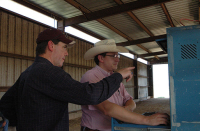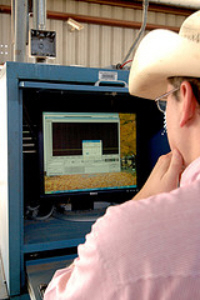



Beef Cattle Studies Focus On RFI
Feed efficiency in beef cattle is getting a closer look by a Texas AgriLife Research scientist, who is evaluating both feedlot performance and feed intake to improve profitability and reduce the environmental impact of beef production systems.Dr Gordon Carstens, an AgriLife Research animal nutrition scientist, along with other agency researchers, has been using GrowSafe technology to measure feed intake and feeding-behavior traits such as daily visits and time spent at the feed bunk.
The technology is part of ongoing research efforts in College Station and the McGregor AgriLife Research Center.
“Calculating residual-feed intake (RFI) is an alternative method of assessing feed efficiency in beef cattle, which is based on the fact that considerable individual animal variation exists in feed intake above and below what is expected on the basis of an animal’s size and growth rate,” Dr Carstens said.
For example, Dr Carstens said to imagine two bulls that both weigh 900 pounds and gain four pounds per day during a performance test.
“For a given ration, we would expect that both bulls would eat say 26 pounds per day because their requirements for maintenance and growth should be similar,” he said. “In reality, one bull may have eaten 24 pounds and the other 28 pounds per day.”

Residual-feed intake is calculated as actual intake minus expected intake based on an animal’s body weight and growth rate, Dr Carstens said.
“So the residual-feed intake would be minus and plus two pounds per day for the two bulls with the efficient bull being the one with a negative residual feed intake.”
Dr Carstens and other scientists have found that residual feed intake is a “moderately heritable” trait that is genetically unrelated to growth traits. Thus, genetic selection for low residual-feed intake offers opportunities to select for improved feed efficiency without having to stock larger, mature cows, he said.
“With increased feed costs in recent years, there are a lot of folks in the industry interested in using this trait as part of a selection program to improve genetic merit for feed efficiency.”
In addition to measuring feeding intake, the GrowSafe system is able to monitor individual feeding patterns by using electronic radio frequency identification device ear tags. Sensors capture each animal’s trip to the feed bunk and the frequency and time of each bunk visit is recorded by the system’s computer software programme.
This data is valuable in evaluating differences in feeding behavior patterns among efficient and inefficient cattle, Dr Carstens said.

“We are interested in learning why some animals are efficient and others aren’t,” he said.
“We are finding that cattle with low residual feed intake actually have lower energy requirements, come to the feed bunk less frequently, spend less time eating each day and tend to have higher digestibilities.”
The technology is robust, allowing for a feed truck to feed cattle in feed bunks each day, thus eliminating the time-consuming task of manual feeding and reducing the cost of collecting feed intake data for genetic evaluation purposes, Dr Carstens said.
“Without a doubt, the recent increase in grain prices the past few years, and higher hay costs caused by the drought will create more demand for cattle with superior genetic merit for feed efficiency,” he said.
“In the past, the beef industry has mainly focused on improving genetics of carcass and growth traits. Most recently, the focus has been on improved efficiency, and yes, the increased cost of feeds and drought has driven more interest in these areas."
“We can now start talking about how to improve efficiency so we can also reduce the environmental impact of beef cattle production systems. Cattle that are more efficient also produce less methane and less fecal output. Several countries are currently exploring the use of these technologies to improve feed efficiency in beef cattle as strategies to mitigate the carbon footprint of animal agriculture.”


